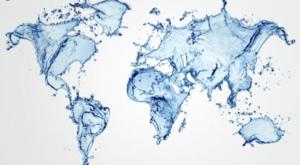
The world's population continues to grow, almost exclusively in the developing countries. Since they are developing, the economy and standard-of-living in these countries are expanding rapidly, and the need for and/or use of resources, and energy and water, are also expanding rapidly. From the perspective of water resources, one of the most critical needs is the improvement and enhancement of membrane systems for water production. Diego Bonta of Dow Water and Process Solutions presented an outline of the issues, and some of the current development efforts in the area of membrane technology.
The Water-Energy Nexus
The Water-Energy Nexus essentially describes the co-dependency between energy and water:

- It takes significant volumes of water to produce energy, most especially for thermoelectric power, and
- It takes significant energy to produce and treat water and wastewater, most especially for seawater desalination.
A partial listing of some of the interrelationships is shown below:
| Energy for Water | Water for Energy |
| Pump and Collect | Thermoelectric Cooling |
| Treat, Purify, and Desalt | Hydropower |
| Pump and Deliver | Energy Minerals Extraction/Mining |
| Extract | Petro- and Biofuels |
| Disinfection | Emission Controls |
| Wastewater Treatment | Oil and Gas Extraction |
The Cost of Desalination
The RO technologies used for desalination require 3-14 kWh per 1000 gallons. The average American uses 168 gallons (equivalent) of water per day, so at an electricity cost of 7.5 cents/kWh and using the high end of the energy requirement, the monthly electricity cost of water is around $5.30. This is only 10-15% of the cost to run a large refrigerator, and over a year's time is roughly equivalent to one tank of gas.
Current RO Membrane Challenges
Regardless of the cost effectiveness of current membrane systems/processes, there are challenges to face in driving the costs down even further. These include:

- Developing improved membranes that require lower pressures but deliver high water flow and quality.
- Use of specialty membrane coatings for reduced fouling.
- Enhancements to reduce the volume of pretreatment chemicals and to reduce cleaning frequency.
- Expanded ability to recover and use "distressed" sources such as wastewater, storm water, and produced water (from the oil and gas extraction industries).
R&D for Water Sustainability
Dow has a commitment to ongoing research and development in the area of advanced water treatment. Current programs are involved in polymer and inorganic science and chemistry, advanced membrane and resin technologies, and increases in selectivity for both membranes and resins.

The current goal is to drive down the total cost of desalination and resuse by 35%. For more information, visit the Dow Water and Process Solutions website, or contact Diego Bonta.



Comments
Interesting to see the relative energy cost of the typical American water demand. And given that a significant portion of that is waste, water supply doesn't take a lot of energy - relatively. But I guess that only applies if there are no transportation needs for the water. Areas removed from any water have extra problems.
Yes. Diego's numbers were averages, of course. I imagine that the cost curve has a very fat tail (on the high side). And getting fatter with each passing year!